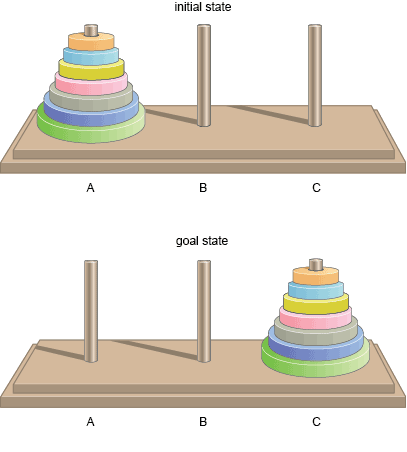2.1 Executive function
Some experimental tests suggest that the profile just described reflects problems with
Tower of Hanoi
The puzzle consists of three pegs, A, B and C, and a set of rings that vary in size. At the start of the test, the rings are arranged in order of size on peg A (see Figure 2). The aim is to move all the rings, one at a time and in as few moves as possible, to peg C, with the constraint that a larger ring can never be placed on top of a smaller ring. To succeed at this task the participant must work out an overall strategy or plan for transferring the rings – the secret is in the way all three pegs, including peg B, are used as ‘staging posts’.
You might like to find an online version of the Tower of Hanoi puzzle (such as this one) and try it for yourself. (Note: neurotypical people as well as autistic people may find this task difficult. No conclusions can be drawn from finding the task challenging.)
Other executive function tasks test flexibility and the ability to generate new ideas.
Watch this video clip, in which Dr Jamie Craig asks first a child with autism, and then a typically developing child to suggest new uses for a piece of foam. You will notice that while both children come up with some ideas, the typically developing child offers a greater and richer range of suggestions (Craig and Baron-Cohen, 1999).

Transcript
Executive function difficulties may be one reason why even able autistic people can find everyday life challenging. Difficulties with everyday organisational tasks are well illustrated in this interview extract with Wenn Lawson (Lawson and Roth, 2011):

